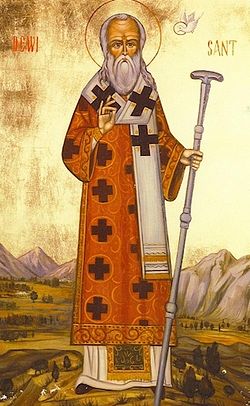
His mother was Saint Nonna (commemorated March 3), who descended from the royal house of Dyfed in Wales. She later became a nun and reposed in Brittany. A number of churches are dedicated to St. Nonna to this day; notably, there are a very ancient chapel and a holy well of St. Nonna not far from her son's cathedral in the city of St. David's, and St. Nonna's Church in the village of Altarnun in Cornwall, England, which probably preserves her relics.
It was said that St. David already worked miracles in his mother's womb. Once pregnant, St. Nonna entered the church to listen to a sermon. But the priest then lost his speech for a while. This was understood as a sign from the Lord that the infant in Nonna's womb was to surpass all teachers of faith in Wales and to become the spiritual father of the Welsh nation.
From childhood, the future St. David excelled in piety and love for the church. He became a monk and a priest when still very young. He was trained in the monastic life in various monasteries of Wales. The fact is that a relatively developed Church and monastic life already existed in Wales by the time of St. David, but it was St. David whom the Lord chose as the greatest saint of this nation, builder of over 10 monasteries and founder of one main spiritual center—an archdiocese. So, the holy hierarch filled the Welsh land with the spirit of holiness and asceticism, providing the country with great spiritual potential and strength for many centuries.
In the year 447 Bishop Germanus of Auxerre returned to Britain from Gaul to struggle with the heresy of Pelagianism, which was spreading at that time in parts of Europe. Not only did St. Germanus succeed in his task, but he also left his disciples in Britain, namely in Wales, the greatest of whom was St. Iltut, founder of the important monastic center at Llantwit Major. St. Iltut is known as the first organizer of monastic life in Wales. This saint, in his turn, had many disciples, who continued and finished his task. Among them were such great Church fathers "of the second generation" as Cadoc, Dyfrig, Paternus, Gildas the Wise, and, of course, David. St. David received spiritual instruction and experience in monastic life from many monastic fathers. Thus, he visited St. Paulinus (whom he healed from sudden blindness) in Whitland and the monastic school in Llantwit Major. Now well prepared in the monastic life and divine knowledge, St. David set off travelling all over the country (following the example of Celtic ascetics), establishing monasteries and churches. In the south of Wales he also healed a local ruler from blindness.
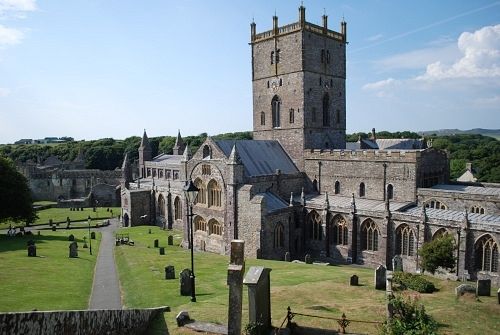 St David's Cathedral, Pembrokeshire
St David's Cathedral, Pembrokeshire In the southwestern part of the country, modern Pembrokeshire, St. David together with his companions (St. Teilio and St. Aidan of Ferns were among them) founded his best-known monastery in Mynyw (the latinized form is Menevia), now called St David's after him. St. David became its abbot. The brethren in Menevia followed a very strict rule. The author of St. David's life stresses that the monks and disciples of St. David read the lives of the desert fathers of Egypt and tried to follow them in their ascetic practices and everyday monastic life as much as they could. The Menevia Monastery, where manual labor and education were always encouraged and flourished, became a true seedbed of saints. Strict discipline under the direction of the abbot was kept in this monastery for very many years. The food of the brethren was very simple and consisted of bread, herbs and water. Alcohol was absolutely excluded, and fish was given only in extreme cases and special occasions.
The abbot led the same simple life as his monks and worked as hard as any of them. All the community members wore simple clothes and all their belongings were held in common. Voluntary poverty and the refusal of all possessions were among the main rules of the monastery. The brethren attended very long church services every day. St. David himself, like many other Celtic saints, used to retreat to the river to read the whole Psalter, standing in cold river water even in winter. Any conversations, except for very necessary ones, were forbidden. Ascetic preparation of the mind and heart in inner prayer was common among Celtic foundations of Wales of that period. The community had the custom of distributing food to those in need, to widows, the sick, the disabled, guests and pilgrims.
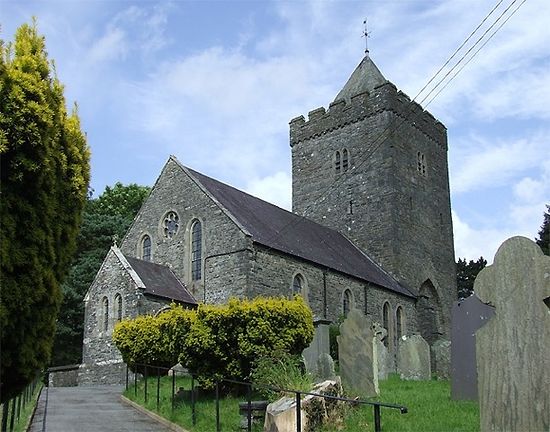 St. David's Church in Llandewi-Brefi, Ceredigion
St. David's Church in Llandewi-Brefi, Ceredigion It is known that St. David participated in the important Church Council of Brefi in Wales, which was held in either 545 or 560. The Council was called to condemn the heresy of Pelagianism and to discuss issues of Church discipline. According to tradition, St. David spoke so eloquently and was so inspired from above at the Council that a hill miraculously rose up under him and a white dove descended onto his shoulder. At this meeting St. David was unanimously elected Archbishop of Menevia and the whole Welsh Church, and his monastery was declared the spiritual capital of the country. The later version of his life claims that St. David was raised to the rank of Archbishop by the Patriarch of Jerusalem in the Holy Land, where the saint travelled together with Sts. Teilio and Paternus.
St. David also stood for purity of the Church from heresies, and so he became known as "the enemy of Monothelites". Many saints, contemporaries of St. David, were his friends; among them was St. Finnian of Clonard, "the father of the saints of Ireland". Tradition says that St. David probably established or, most likely, restored monastic life in Glastonbury in Somerset.
The glory of St. David as wonderworker, a preacher from God and a great helper of the people spread all over Britain and Ireland. The saint worked many miracles during his life and after his repose. Once he gave a traveller a horse, which took him across the sea. St. David and his disciples preached the Gospel very zealously, especially in south Wales, and their fame spread from there to many other kingdoms and lands. Many rulers and princes, hearing St. David's sermons, gave away their riches to the poor and in some cases even left their thrones and took up monastic life. St. David used to say: "Be joyful, brothers and sisters, keep the holy faith and do your little good works", and also: "Always rejoice and be in the faith. Do the same little deeds that I did: you yourselves saw them and heard of them. I am following the path which our fathers walked before us."
 St. David's Church, Caldey Island
St. David's Church, Caldey Island The holy hierarch David reposed in the Lord on March 1, 589 (according to another version: 601). After the repose of St. David, veneration grew more and more, spreading from south Wales throughout the whole country, and from there to Ireland, Cornwall (which had very close spiritual ties with Wales and in fact monastic life in Britain first appeared in Tintagel in north Cornwall), parts of western England and Brittany. Some scholars suppose that St. David made frequent trips to Cornwall, Brittany and other regions where he built monasteries. For every Welshman, St. David is an embodiment and personification of Wales.
The relics of St. David have survived and are in the magnificent St. David's Cathedral (12th-14th centuries) in Wales to this day. This Cathedral stands precisely on the site of the original monastery established by David. Pilgrims come here every year. St. David's monastery existed for many centuries, though in the 10th and 11th centuries it was plundered by the Vikings. His relics were greatly venerated by the faithful till the Reformation, when his splendid and richly decorated shrine was ravaged and desecrated; however, the holy bishop's relics survived. The saint’s shrine was restored through efforts of dean of St. Davids Cathedral in 2012 and solemnly installed at the Trinity Chapel for veneration. The niches at the foot of the shrine contain reliquaries with relics of St. David and St. Justinian of Ramsey, his disciple. Three newly-painted icons at the front of the shrine depict Sts. Patrick, David and Apostle Andrew; at the rear of the shrine there are icons of Sts. Nonna and Justinian. The author of the icons is the local icon painter Sarah Crisp. A painted and decorated canopy is installed above the shrine; wooden carvings on its top represent aspects of lives of the saints depicted on icons.
By the second half of the 20th century at least 50 churches were dedicated to St. David. Thus, a 12th-century Norman church in the village Llandewi-Brefi in the Welsh county of Ceredigion is dedicated to him. The church stands on the same site where the Council of Brefi took place and on the small hill that grew beneath the saint's feet; among its treasures is a statue of St. David, along with Celtic crosses. St. David is usually depicted on icons as a bishop with a dove on his shoulder, standing on a height (elevation). March 1, the feast-day of St. David, is the national holiday of Wales. On this day Welsh people wear a daffodil—an old emblem of the saint—in their buttonholes. Probably this is due to the similarity between the flower's name and the saint's name (in Welsh a daffodil is a "dafid").
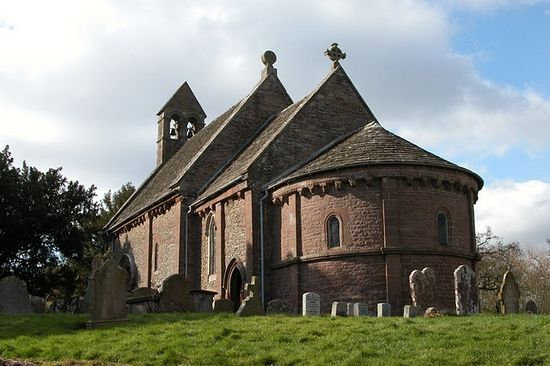 St. Mary's and St. David's Church in Kilpeck, Herefordshire
St. Mary's and St. David's Church in Kilpeck, Herefordshire Among the many parish churches dedicated to St. David in England, we can mention the historic St. Mary's and St. David's Norman Church in the village of Kilpeck in Herefordshire (it contains a great many carved stone figures of people, angels, and even animals); St. David's Church in the village of Little Dewchurch in Herefordshire, St. David's Church in the small town of Moreton-in-Marsh in Gloucestershire, the churches of St. David in the village of Ashprington and in the city of Exeter in Devon; St. David's Church in the city of Birmingham in West Midlands and others. There is also a Russian Orthodox parish of St. David in the city of Derby in central England.
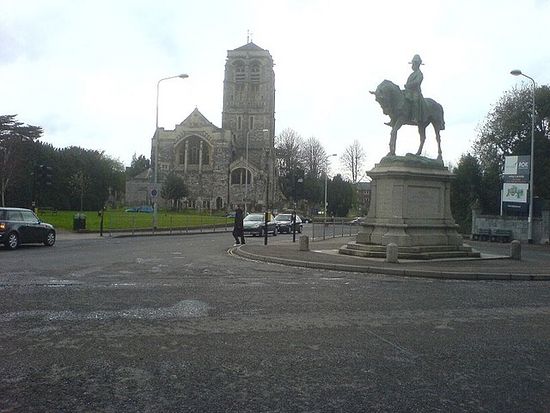 St. David's Church in Exeter, Devon
St. David's Church in Exeter, Devon 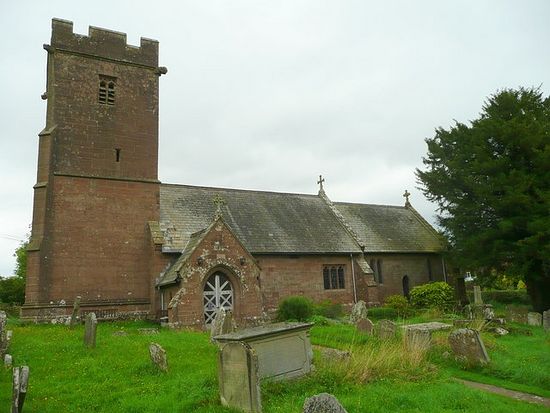 St. David's Church in Little Dewchurch, Herefordshire
St. David's Church in Little Dewchurch, Herefordshire Of the more important churches dedicated in Wales to its patron, there are: St. David's Church in the town of Denbigh in the county of Denbighshire (in the late 16th century the Earl of Leicester began building this church as a future cathedral but it was never finished); the former St. David's Abbey Church in the village of Henfynyw in Ceredigion (the saint himself was probably instructed for some time in the local monastery; there is a holy well of St. David nearby); St. David's Church on Caldey Island (part of it is from the 6th century; it was used as a smithy for some time but was restored in 19th century), and many others. Churches dedicated to St. David can also be found in countries like Australia, New Zealand and the USA.
Holy Hierarch David, pray to God for us!

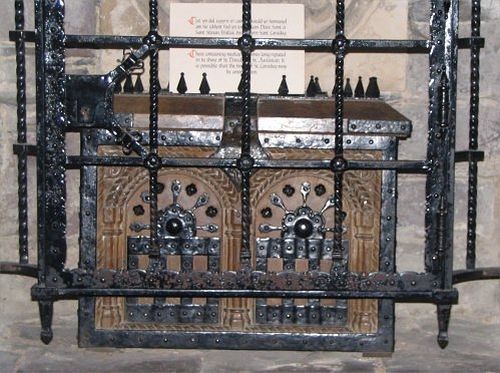
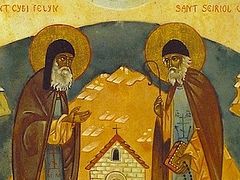
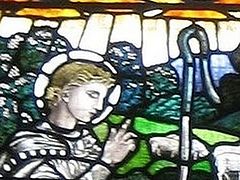
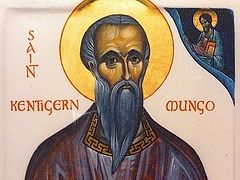
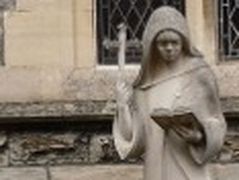
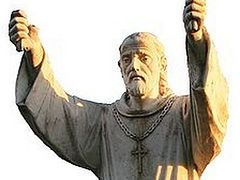
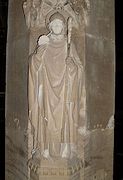
Thank-you for this wonderful service of making the saints of Britain better known. It was good to read about my holy patron St. David today on his feast and my name's day!
Fr. David Belden, St. Theodore of Canterbury Orthodox Mission, Toronto, Ontario, Canada
(the only English-language parish of 30!!! in Toronto following the Church, rather than the civil, calendar.